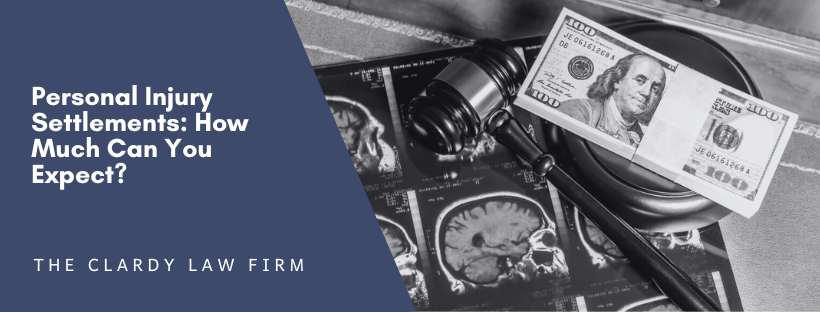Millions of people are seriously injured in accidents caused by someone else’s negligence or recklessness every year.
In South Carolina, one person is injured in a car accident every nine minutes. The statistics are shocking, but that’s without considering the hundreds of thousands of people injured every year in motorcycle accidents, accidents at work, devastating truck accidents, and more.
The South Carolina Department of Public Safety published its Traffic Collision Fact Book with the latest data from 2021. The report reveals key insights into the root causes of car accidents and fatal crashes in South Carolina.
Incidents happen every few minutes, on average. In 2021, there was:
- One traffic collision every 3.6 minutes (147,724)
- One property damage collision every 4.8 minutes (110,152)
- One injury collision every 14.4 minutes (36,460)
- One fatal collision every 7.9 hours (1,112).
If you’ve been injured in an accident, you might be wondering how much you can expect from a personal injury settlement. We examine whether there is such a thing as an “average” personal injury settlement, how settlements are calculated, and how much you could be entitled to.
When Can You Claim a Personal Injury Settlement?
A personal injury lawsuit is a civil claim that allows victims of an accident to claim compensation.
However, a successful case relies on significant evidence. As personal injury claims are based on negligence, the burden of proof falls on the claimant to show that another other party was at fault.
To meet the legal definition of negligence, you must prove four criteria:
- That another party’s negligence or recklessness caused the injury — To succeed in a personal injury claim, you must demonstrate that another party’s negligence or recklessness directly caused your injury. This negligence could involve actions such as careless driving, failure to maintain safe premises, or medical malpractice. You need to provide evidence showing how the defendant’s actions or omissions led to the accident and resulting harm.
- That the party owed the individual a duty of care — Every individual or entity owes a duty of care to others to act reasonably and avoid causing harm. For example, drivers have a duty to operate their vehicles safely, property owners have a duty to maintain a safe environment for visitors, and medical professionals have a duty to provide competent care to patients. In your personal injury case, you must establish that the defendant owed you a duty of care relevant to the circumstances of the accident.
- That this duty was breached (via a negligent or reckless act) — Once you establish that the defendant owed you a duty of care, you must prove that they breached that duty through negligent or reckless conduct. This breach could involve actions such as speeding, ignoring safety regulations, or failing to warn of potential hazards. Your evidence should demonstrate how the defendant’s actions fell short of the expected standard of care, directly leading to your injury.
- That you are suffering monetary injury as a result of the accident — In addition to proving the defendant’s negligence and breach of duty, you must show that you suffered monetary injury sustained as a direct result of the accident. This includes various economic damages such as medical bills, lost income due to inability to work, property damage, and other financial losses. You need to provide documentation and evidence supporting the extent of your financial losses to claim compensation for these damages.
Successfully meeting these criteria strengthens your personal injury case and increases the likelihood of obtaining a settlement or judgment in your favor. It’s essential to gather as much evidence as possible, including the police report, witness statements, medical records, accident reports, and expert opinions, to support your claim and demonstrate the defendant’s liability. Consulting with a qualified personal injury attorney can also provide valuable guidance throughout the legal process.
How to Prove Negligence in Personal Injury
To be entitled to personal injury compensation, you need to show that the other party owed you a duty of care. This is a legal obligation to ensure the safety and well-being of others. For example, doctors have a duty of care to look after the health of their patients, but a duty of care applies in many situations. When you’re driving on the road, you have a duty of care to drive safely and obey the law. This means that if you sustained a head injury in a car accident because another driver was intoxicated, a car accident lawyer could argue that they breached this duty and that their negligence — driving while intoxicated — caused the injury.
Some of the most common accidents include birth injuries, medical malpractice, motorcycle accidents, truck accidents, car accidents, work injuries, and nursing home abuse.
In proving negligence, you must also have evidence of the costs resulting from the injury. These can include:
- Medical expenses
- Loss of income or potential earnings
- Property damage.
- These quantifiable costs can be easily calculated, but you can also claim additional “non-economic” damages for pain and suffering, mental anguish, and loss of enjoyment.
Proving all these points requires substantial evidence, including bills and receipts, witness testimony, and police reports. A personal injury lawyer in Greenville, SC can help you gather evidence to build a strong case.
Factors Affecting Personal Injury Settlements
- Severity of Injuries: The extent of your injuries significantly impacts the potential settlement amount. Severe injuries that result in long-term disability, chronic pain, or permanent impairment generally lead to higher settlements compared to minor injuries.
- Liability and Fault: Establishing fault is crucial in personal injury cases. If liability is clear and the other party’s negligence is well-documented, it strengthens your case and can lead to a higher settlement. However, if there is shared fault or contributory negligence, it can affect the settlement amount.
- Insurance Policy Limits: The at-fault party’s insurance coverage limits play a role in determining the maximum settlement amount. If the responsible party has minimal coverage, it may limit the available compensation, even if the damages exceed the policy limit.
- Legal Representation: Hiring an experienced personal injury attorney can significantly impact the outcome of your case. A skilled lawyer can negotiate with insurance companies, gather evidence, and advocate for your best interests, potentially leading to a higher settlement.
- Economic Damages: In addition to medical expenses and lost wages, economic damages may include future medical costs, rehabilitation expenses, and diminished earning capacity. Calculating these damages accurately is essential for maximizing your settlement.
- Non-Economic Damages: Pain and suffering, emotional distress, and loss of enjoyment of life are examples of non-economic damages. While these damages are more challenging to quantify, they can substantially increase the overall settlement amount, especially in cases of significant emotional trauma or permanent disability.
- Negotiation Skills: The negotiation process between your attorney and the insurance company can impact the final settlement. Skilled negotiators can leverage evidence and legal arguments to achieve a favorable outcome.
- Jury Verdicts and Precedents: Past jury verdicts and settlement amounts in similar cases can influence the negotiation process. Your attorney may use these precedents to support your claim and justify the requested settlement amount.
How Much Is the Average Personal Injury Settlement?
Unfortunately, there’s no such thing as an average personal injury settlement, as every situation is unique. However, the hard costs associated with your injuries can give you an indication of how much your personal injury claim might be worth.
These costs include any medical expenses incurred and future treatment costs, repair costs for damage to your vehicle, and loss of earnings. This figure forms the basis of your claim. Once this is calculated, an insurance adjuster will apply a multiplier to account for non-economic damages and calculate your total personal injury settlement.
This multiplier is determined on a case-by-case basis and will depend on the formula the at-fault party’s insurance company uses, but ultimately, the bigger the impact of your injury on your life, the more you’ll typically be entitled to.
For example, if you’re in a car accident and have a broken wrist that heals after a few months with no further issues, the multiplier will likely be at the lower end of the scale. However, if you have a traumatic brain injury, or you are left with permanent scars, a life-long disability, or dependent on others to carry out daily tasks, you’ll be entitled to far more.
Here are some hypothetical examples:
- Minor Injuries: For minor injuries like sprains, strains, or minor cuts that result in a quick recovery with minimal medical treatment, the settlement amount might range from a few thousand dollars to tens of thousands of dollars.
- Moderate Injuries: In cases involving more moderate injuries such as fractures, back injury, concussions, or injuries requiring surgery but with a good prognosis for recovery, the settlement amount might range from tens of thousands to a couple of hundred thousand dollars.
- Severe Injuries: Cases involving severe injuries such as traumatic brain injuries, spinal cord injuries resulting in paralysis, loss of limbs, or other permanent disabilities can result in settlements ranging from hundreds of thousands to millions of dollars.
- Wrongful Death: In wrongful death cases, where a loved one dies due to someone else’s negligence or intentional actions, settlements can vary widely depending on factors such as the deceased’s earning potential, age, and the impact on surviving family members. Settlements in wrongful death cases can often reach into the millions of dollars.
- Pain and Suffering: Non-economic damages like pain and suffering are often factored into settlements. The amount for pain and suffering can vary significantly based on the severity and duration of the pain experienced by the victim.
- Post-Traumatic Stress Disorder (PTSD): You can claim for PTSD in personal injury cases under certain circumstances. PTSD can result from experiencing or witnessing a traumatic event, such as a car accident, assault, or other forms of personal injury incidents. If someone else’s negligence or intentional actions caused the traumatic event that led to your psychological damage, you may be entitled to compensation.
Another method of calculating pain and suffering is “per diem” — or “for each day.” This involves assigning a monetary amount for each day you suffer.
For example, if you are younger and left disabled after your accident, you’ll typically receive a larger personal injury settlement because you’ll have to live with the consequences of your accident for a long time.
It’s important to note that each personal injury case is unique, and how much compensation you are entitled to is determined based on the specific facts and circumstances of the case, as well as negotiations between the parties involved. Consulting with a personal injury attorney experienced in South Carolina law is crucial for estimating potential settlement amounts and navigating the legal process.
Personal Injury Lawsuit Statute of Limitations
Each state has a statute of limitations for personal injury claims. In South Carolina, the statute of limitations for a personal injury claim is three years from the accident date. While this can seem like a long time, it will likely pass quickly, so it’s vital to contact a lawyer as early as possible.
How to Claim a Personal Injury Settlement
If you’ve been injured in an accident due to someone else’s actions and believe you can file a claim for a personal injury settlement, it’s vital to get in touch with an attorney.




